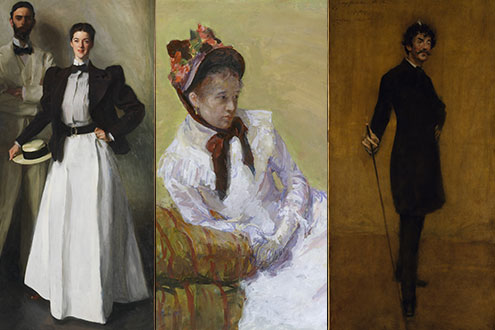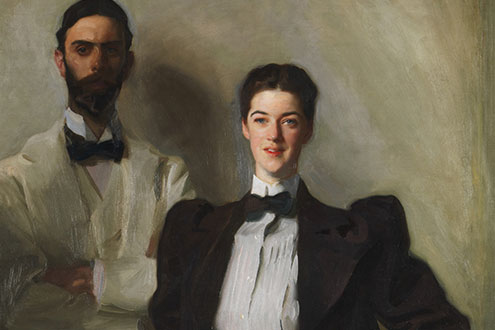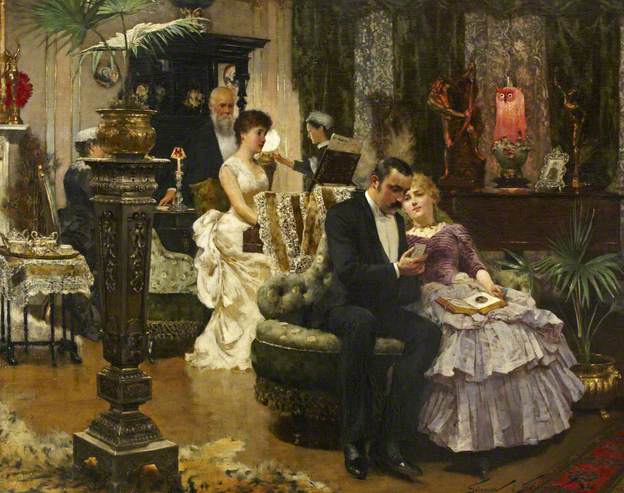Henry James took to Europe his delicate sensibilities, and later Hemingway took his lusty appetites; today the idea of innocence abroad lingers but tenuously, as the rejection of home…
The American emigre movement to Europe had its beginnings in the rose and gray candlelit years in the middle of the nineteenth century, when there was nobody to understand its humors or chart its progress. Not, that is, until Henry James arrived on the scene and took upon himself the role of critic and interpreter, noting the symptoms of the etiology of expatriation from the New World. The innocent abroad had engaged the attention of Hawthorne and Mark Twain, but it was for James to mine the subject and develop it into the unifying theme of his life’s work.

—mage above: John Singer Sargent (American 1856–1925), Mr. and Mrs. I. N. Phelps Stokes (detail), 1897. Oil on canvas, 84 1/4 x 39 3/4 in. (214 x 101 cm). The Metropolitan Museum of Art, New York, Bequest of Edith Minturn Phelps Stokes (Mrs. I. N.), 1938 (38.104); Mary Cassatt (American, 1844–1926 ), Portrait of the Artist (detail), 1878. Watercolor, gouache on wove paper laid down to buff-colored wood-pulp paper, 23 5/8 x 16 3/16 in. (60 x 41.1 cm). The Metropolitan Museum of Art, New York, Bequest of Edith H. Proskauer, 1975 (1975.319.1); William Merritt Chase (American 1849–1916), James Abbott McNeill Whistler (detail), 1885. Oil on canvas, 74 1/8 x 36 1/4 in. (188.3 x 92.1 cm). The Metropolitan Museum of Art, New York, Bequest of William H. Walker, 1918 (18.22.2).—click image for source…
At first he was the “sentimental” – afterward the “analytic” – tourist, and one of a distinguished and glittering galaxy of American visitors, many, like himself, of New England origins: the sculptors William Wetmore Story and Harriet Hosmer; William Dean Howells, Lincoln’s consular appointment at Venice; and, later, Bernard Berenson-travelers who, like Mark twain describing himself as being “of Hartford, Connecticut, and Settignano,” had a way of settling in and establishing residence by the simplest means, that of having letter paper printed with two addresses, one American and one foreign.

—Image above: John Singer Sargent (American 1856–1925), Mr. and Mrs. I. N. Phelps Stokes (detail), 1897. Oil on canvas, 84 1/4 x 39 3/4 in. (214 x 101 cm). The Metropolitan Museum of Art, New York, Bequest of Edith Minturn Phelps Stokes (Mrs. I. N.), 1938 (38.104)—click image for source…
There were non-entities too, heiresses to manufacturing fortunes, mindless darlings under the tutelage of the inevitable maiden aunt, in serious pursuit of titled, but Protestant marriage, and art historians- evidently as ubiquitous then as now- respectfully cataloguing and annotating the extant work of Sansovino or Longhena and developing a taste for wine with their boarding house meals. James watched them carefully, and we see them through his eyes: the Sargent family as the gypsing Moreens in his story The Pupil; and Francis Boott of Newport, later of Bellosguardo, who, with his daughter Lizie, sat for Gilbert and Pansy Osmond in The Portrait of a Lady.

—The Conversation Piece by Solomon Joseph depicts the genteel transatlantic society of Henry James.
Leighton House Museum, Kensington & Chelsea, London, UK/ The Bridgeman Art Library International—click image for source…
Henry’s brother William crossed the Atlantic in 1892 to receive an honorary degree at padua, and, seeing the invaders in such large numbers everywhere he looked, concluded that, after all, American were better off where they came from. There wasn’t much “vitality” abroad; Italy was shabby and decadent, its influence upon the vigorous youngsters from home was unhealthy. But for his brother Henry it was still a country brushed with charm and magic and courted by its devoted American lovers, those “old-time victims of Italy.” ( to be continued)…
ADDENDUM:
(Mark Twain, Innocents Abroad, 1869):The dance had begun, and we adjourned to the temple (1). Within it was a drinking-saloon; and all around it was a broad circular platform for the dancers. I backed up against the wall of the temple, and waited. Twenty sets formed, the music struck up, and then–I placed my hands before my face for very shame. But I looked through my fingers. They were dancing the renowned Can-can. A handsome girl in the set before me tripped forward lightly to meet the opposite gentleman–tripped back again, grasped her dresses vigorously on both sides with her hands, raised them pretty high, danced an extraordinary jig that had more activity and exposure about it than any jig I ever saw before, and then, drawing her clothes still higher, she advanced gaily to the center and launched a vicious kick full at her vis_a_vis (2) that must infallibly have removed his nose if he had been seven feet high. It was a mercy he was only six.
That is the Can-can. The idea of it is to dance as wildly, as noisily, as furiously as you can; expose yourself as much as possible if you are a woman; and kick as high as you can, no matter which sex you belong to. There is no word of exaggeration in this. Any of the staid, respectable, aged people who were there that night can testify to the truth of that statement. There were a good many such people present. I
ose French morality is not of that strait-laced description which is shocked at trifles.I moved aside and took a general view of the Can-can. Shouts, laughter, furious music, a bewildering chaos of darting and intermingling forms, stormy jerking and snatching of gay dresses, bobbing heads, flying arms, lightning flashes of white-stockinged calves and dainty slippers in the air, and then a grand final rush, riot, a terrific hubbub, and a wild stampede! Heavens! Nothing like it has been seen on earth since trembling Tam O’Shanter saw the devil and the witches at their orgies that stormy night in Alloway’s auld haunted kirk .





 COMMENTS
COMMENTS